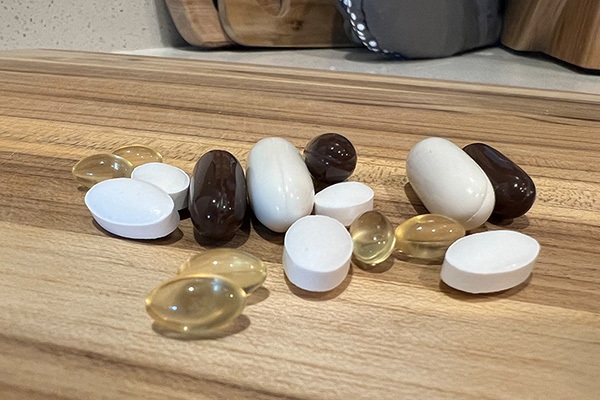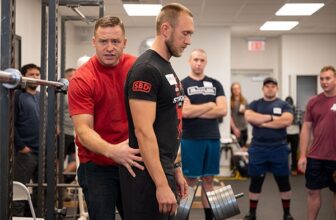
[adinserter block=”2″]
Over the last century vitamins have been one of the most popular dietary supplements on the market. They are often purported to have a multitude of benefits that directly contribute to improvements in various physical capabilities. Gyms and sports nutrition stores worldwide have made broad claims about the need for vitamin supplementation to enhance performance, boost energy, and accelerate fat loss. In fact, when I first became a member of commercial gym weight rooms back in the early 2000s, I was told by gym trainers and salesman at the local sports nutrition store that multivitamins were “the basics” in terms of supplementation. This implication was that these are a requirement for anyone serious about lifting weights, losing bodyfat, or doing anything resembling vigorous physical exertion.
Years later as a dietetics student, I was taught to advocate for whole food consumption to ensure adequate vitamin intake and that supplementation was entirely unnecessary. Both approaches had their merits, and like most things in modern life the nugget of truth in both positions is often lost in the effort to persuade you to adopt a position, purchase a product, or simply validate the salesperson, trainer, or university professor’s need to be right. This article approaches the topic as a practical matter and discusses the role of vitamins in human nutrition and in the context of strenuous barbell training.
Water Soluble Vitamins
Vitamins are typically classified based on their solubility in water or fat. As the name suggests water soluble vitamins dissolve in water. They consist of eight B-vitamins (also referred to as the B-complex) and vitamin C (ascorbic acid). An in-depth biochemical analysis of each vitamin can be found in a biochemistry textbook and includes far more detail than anyone needs to know to optimize nutrition for physical performance. A brief background followed by general characteristics and a food source guide is sufficient for these purposes. As much as I enjoy some good biochemistry, deep dives into micronutrient metabolism often can be distracting for a lifter interested in learning how to eat. In this series of articles, we will address vitamins by function versus solubility. Thus, we will limit this discussion to B-Vitamins.
The term “vitamin” originates from “thiamine,” also spelled thiamin. Thiamin, or Vitamin B1, is one of eight B vitamins and was discovered in the early 20th century by Casimir Funk. Since food production was not as advanced as it is today, many people suffered from what are now recognized as nutrient deficiencies. Relationships between nutrient deficiencies and the absence of certain foods were observed early on. Specifically, beriberi appeared to be less likely to be prevalent in individuals who consumed brown rice. Funk learned of this and was determined to isolate the substance and mechanism responsible for this.
Once isolated, it was learned that the substance contained an amine group (NH), which led to him coining the term “vital amines” or “vitamines,” which served as the title of his book The Vitamines. The “e” was later dropped from the name as additional vitamins were identified that did not contain amine groups. Common characteristics of each B-vitamin can be found below. The Recommended Daily Allowance (RDA) or Adequate Intake (AI) assumes baseline physical activity levels (i.e. no serious training and probably mostly sedentary). As we will discuss further, training likely requires a greater intake due to its physiological effects on the human body. More on this below.
Table of B Vitamins
|
Vitamin |
Food Sources |
Functions |
Toxicity |
Deficiency |
Suggested amount |
|
Thiamin (B1) |
Pork, yeast, nuts, legumes, sesame seeds, whole grains. |
Energy Production, Nutrient metabolism, CNS function |
No Tolerable Upper Limit |
Beriberi (Dry, Wet, and Acute). Can stem from alcoholism. |
RDA Men: 1.2 mg/d Women: 1.1 mg/d |
|
Riboflavin (B2) |
Milk, Beef Liver, Beef, clams, Mushrooms, Egg yolks, Almonds |
Energy Production, B12 metabolism, Vitamin A conversion, Neurotransmitter metabolism (dopamine), DNA synthesis |
No Tolerable Upper Limit |
Ariboflavanosis (rare in isolation). Can stem from hypothyroidism, diabetes, trauma, stress, and alcoholism. |
RDA Men: 1.3 mg/d Women: 1.4 mg/d |
|
Niacin (B3) |
Beef Liver, Chicken Breast, Turkey Breast, Salmon, Tuna, Pork, Brown Rice, Peanuts |
Energy Production. Cholesterol and steroid hormone synthesis, DNA synthesis. |
35 mg/d can have vasodilatory effects (“Niacin Flush). High doses can treat acne vulgaris and hyperlipidemia as tolerated. |
Pellegra (pelle = “skin” agra = “rough”). Manifests as “4 Ds” (Dermatitis, Dementia, Diarrhea, and Death). |
RDA Men: 16 mg Niacin Equivalents per day Women: 14 mg Niacin Equivalents per day |
|
Pantothenic Acid (B5) |
Beef Liver, Chicken Liver, Sunflower Seeds, Avocados, fortified cereals, shiitake mushrooms, Salmon, Corn, Lentils |
Energy production, brain formation, nutrient metabolism, cholesterol synthesis. |
No toxicity reported. 15-20 g associated with gastrointestinal distress. |
“Burning Foot Syndrome,” which is rare. Burning feet and neuritis. B5 deficiency often not in isolation and due to alcoholism, diabetes, and other conditions that impair nutrient absorption. |
AI Men: 5 mg/d Women: 5 mg/d |
|
Pyridoxine (B6) |
Beef Liver, Tuna, Salmon, Fortified Cereals, Baked Potato, Chickpeas, Poultry |
Glycogen degradation, energy production , hepatic (liver) glucose production, Amino acid metabolism, DNA synthesis, CNS function, niacin synthesis from tryptophan, heme synthesis (first step). |
|
Deficiency is rare and manifests as Seborrheic dermatitis on the face, cheeks, neck, shoulders, and buttocks. Additional symptoms include weakness, fatigue, glossitis, and neurological abnormalities. Can also lead to hypochromic microcytic anemia. Older adults and alcoholics at highest risk. |
RDA Men: 1.3 mg/d; 1.7 mg/day for men over 50. Women: 1.3 mg/d, for women over 50: 1.5 mg/d. |
|
Biotin (B7) |
Chicken liver, Cooked egg yolks, Legumes, sunflower seeds, almonds, beef liver, Sweet potatoes, |
Synthesized by colonic bacteria. Bicarbonate carrier for energy production. Necessary for amino acid and fatty acid breakdown. |
No tolerable upper limit reported. |
Rare from diet. Can result from high raw egg white consumption due to avidin. Hypertension and alcoholism can also cause deficiency. Symptoms include lethargy, dermatitis, depression, hallucinations. |
AI 30 μg per day for adults |
|
Folate (B9) |
Beef Liver, Legumes, Asparagus, Eggs, Spinach, Kale, Arugula, Beets, Brussel Sprouts, Oranges, grapefruit, lemons , and limes, |
DNA synthesis, amino acid metabolism, methionine synthesis, CNS function. Folate naturally found in food. Folic acid not naturally found in food; fortification and supplementation. Relevant biochemical reactions also require B12 and B6. |
Tolerable Upper Limit for Adults: 1000 μg/d due to its ability to mask B12 deficiencies. Side effects with high intakes include insomnia, irritability, and GI distress. |
Megaloblastic Macrocytic Anemia, Hyperhomocysteinemia, reduced oxygen carrying capacity due to impairment in DNA synthesis. |
RDA 400 μg/d for adult men and women |
|
Cobalamin (B12) |
Liver and kidney (lamb liver**), shellfish, sardines, beef, Tuna, Trout, Salmon, Milk and dairy products, Eggs |
CNS function, DNA synthesis, conversion of homocysteine to methionine. |
No tolerable upper limit. |
Megaloblastic Macrocytic Anemia due to impairment in DNA synthesis. Strict vegans are at high risk. Can lead to neurological disorders if left untreated. If deficiency is due to malabsorption, intramuscular injections are necessary. |
RDA 2.4 μg/d for Adults, although higher (4-20 μg/d) have been recommended. |
The
function of B-vitamins can be divided into coenzyme
functions and
non-enzymatic functions. The coenzyme function refers to their role
in biochemical reactions that occur in the human body, of which there
are a multitude. As shown in our table, the enzymatic function of one
vitamin often depends on sufficient intake of another vitamin (e.g.
B12, Folate, and B6). Like our muscles, B-Vitamins typically do not
function in isolation. A deficiency in one can impact the function of
another.
Many
of these functions directly pertain to barbell training. Our central
nervous system depends on B6, Folate, and B12 to function properly.
Our central nervous system is also responsible for eliciting muscle
contractions. Niacin, Riboflavin, Thiamin, Biotin, and Pantothenic
Acid are required for energy production. Vitamin B6 is necessary for
synthesizing glycogen, which provides fuel during high intensity
muscle contractions. Vitamin B6 may also be needed in greater amounts
for those consuming higher protein intakes and/or having greater
protein turnover due to its role in protein metabolism. All of these
are examples of processes that obviously occur during heavy physical
exertion whether it be competitive marathon or a heavy set of five
deadlifts.
There
are currently no established guidelines for recommended vitamin
intakes for athletic populations. Some have made the silly argument
that trained individuals do not need additional vitamins while
acknowledging that trained individuals need more calories and
macronutrients
from
foods that
contain these vitamins. The
current recommended intake amounts are based on untrained populations
of people. There are additional requirements for untrained older
adults or pregnant females. Older adults need more due to the gradual
reduction in nutrient absorption that accompanies aging as well as a
general reduction in appetite. Pregnant and post-partum women have
higher metabolic needs due to the demands of childbirth and milk
production.
However,
are we expected to ignore the increased
metabolic demand from heavy training sessions?
It is clear that heavy physical exertion requires more energy, and
more energy production will require more of these micronutrients to
facilitate the relevant biochemical reactions. The argument on the
dietetic side has been that any additional needs will be met with
food. However, as a practicing dietitian it has been my experience
that many individuals struggle to eat a 100% well-balanced diet
despite the best intentions.
This
is not to say that lifters have a poor diet, rather this highlights
how individual food preferences and logistics can create legitimate
barriers to eating a high intake of certain foods such as a large
quantity of vegetables several times per day. Additionally, nutrient
losses due to environmental factors (e.g. light, oxygen exposure) and
cooking/preparation methods can also lead a reduction in vitamin
content for a given food. Taken together, it may be practically
difficult to get 100% of the ideal intake of 100% of these vitamins.
Thus,
the sports nutrition side of the argument is that even with the best
attempts at a well-balanced diet, it is likely that people may still
fall short. Who is correct? We do not really know because we have no
reliable way to answer such a question. What we do know is that many
of these vitamins do not have a tolerable upper limit and are
excreted in urine, so the biggest risk of supplementing some of these
is the risk to your wallet, which is one you will have to assess when
conducting a budget analysis. My general recommendation is that if
you find yourself missing out on key food groups, consuming more
alcohol than you should, or are a vegan, then it wouldn’t hurt to
supplement the B-complex along with the other vitamins that I will
discuss in future articles.
The
most important thing to understand about nutritional science is that
we don’t really have much of it. The lack of reliable and valid
dietary intake data leaves us in the dark in terms of what we
actually need.
The discovery of nutrient deficiencies in the early 20th century shined a light on our need for various micronutrients and has
contributed greatly to our understanding. However, there is still
much to be learned, and as it stands now more vitamins in your life
is unlikely to kill you. So do your squats, drink your milk, and take
your Flintstones in the meantime.
Discuss in Forums
[adinserter block=”2″]
Credit : Source Post






